
The card dispute process is a formal safety net for consumers. It's the official route a cardholder takes to challenge a transaction on their statement and ask their bank for a refund. Think of it as a built-in protection system for situations like billing errors, services that weren't delivered, or straight-up fraudulent purchases.
What Is a Card Dispute and Why Does It Happen?

Ever scanned your credit card statement and found a charge that made you scratch your head? Or maybe you ordered something online that simply never arrived. When things like this go wrong, you don't just have to eat the cost. That's exactly what the card dispute process is for—it's your path to getting that money back.
At its heart, a dispute is just a cardholder telling their bank, "Hey, this charge isn't right." This single action triggers a formal investigation that pulls in several different players, which we’ll get into in a bit.
It's Not Always Obvious Fraud
When people think of disputes, a stolen credit card is usually the first thing that comes to mind. While that's certainly a valid reason, it's far from the only one. Many disputes are born from simple mix-ups or service issues. The whole system is designed to fairly resolve conflicts when getting a direct refund from the merchant isn't working out.
Some of the most common triggers for a card dispute include:
- Billing Errors: The customer was charged the wrong amount or, even worse, billed twice for one purchase.
- Product Not Received: The goods were paid for but never made it to the customer's doorstep.
- Service Not as Described: The product or service was worlds away from what was advertised.
- Recurring Subscription Issues: The customer was charged for a subscription they know they canceled.
The Problem of "Friendly Fraud"
Here’s a tricky one: a growing number of disputes have nothing to do with merchant error or actual criminal activity. They're a result of what the industry calls "friendly fraud," where a customer disputes a completely legitimate charge. Sometimes it's out of confusion, but often it's just a convenient way to get a refund without talking to the merchant.
This isn't a small problem. Recent research shows this behavior now drives up to 75% of all chargebacks, hitting US merchants with over $170 billion in losses every year. This trend is a huge reason why businesses need to understand the full spectrum of dispute reasons. You can dig deeper into these numbers in the 2025 'Cardholder Dispute Index' research from Chargebacks911.
Ultimately, whether it's an honest mistake, criminal intent, or something in between, knowing the different reasons for a chargeback is the first, most critical step to getting them under control.
Meet the Key Players in a Card Dispute
A card dispute isn’t a simple two-way conversation between a customer and a business. It’s more like a multi-stage relay race, with the baton being passed between several key players, each with a specific role to play.
Getting a handle on who does what is the first step to making sense of the whole card dispute process.
Let's break down the lineup.
The Cardholder and the Merchant
It always starts with these two. The Cardholder is your customer—the person who made the purchase and is now questioning the charge on their account. They're the one who kicks the whole thing off by calling their bank to complain.
On the other side of the transaction is you, the Merchant. You're the business that sold the product or service. Once a dispute is filed, you’ll get a notification and a choice: either accept the chargeback or fight it by providing evidence that the sale was legit.
A common mistake is thinking the Merchant and Cardholder hash it out directly. In reality, their banks are the intermediaries, managing all the communication and evidence according to a strict set of rules.
The Issuing Bank and the Acquiring Bank
This is where the financial institutions step in to referee the match. The Issuing Bank is the bank that gave the credit or debit card to the customer in the first place. Think of it as the cardholder's bank (like Chase, Bank of America, or a local credit union).
When their customer files a dispute, the Issuing Bank reviews the claim. If it seems plausible, they'll give the customer a provisional credit and officially start the chargeback process against the merchant.
The Acquiring Bank is your bank—the institution that processes your business's card payments. It receives the chargeback from the Issuer and passes it along to you, along with a request for evidence. The Acquirer represents your interests throughout the process.
To really get a feel for how these banks work together, you can dive deeper into the differences between an acquirer vs. issuer and their specific jobs in the payment chain.
Navigating the Card Dispute Process Step by Step
Understanding the journey of a card dispute can feel like trying to follow a complex legal drama, but it actually follows a clear and predictable path. Think of it as a formal, structured conversation between banks, guided by a strict set of rules and timelines.
Let’s walk through the entire lifecycle, from the moment a customer raises an eyebrow at a charge to the final decision.
This visual gives you a bird's-eye view of how the cardholder, merchant, and their respective banks all play a role in the process.
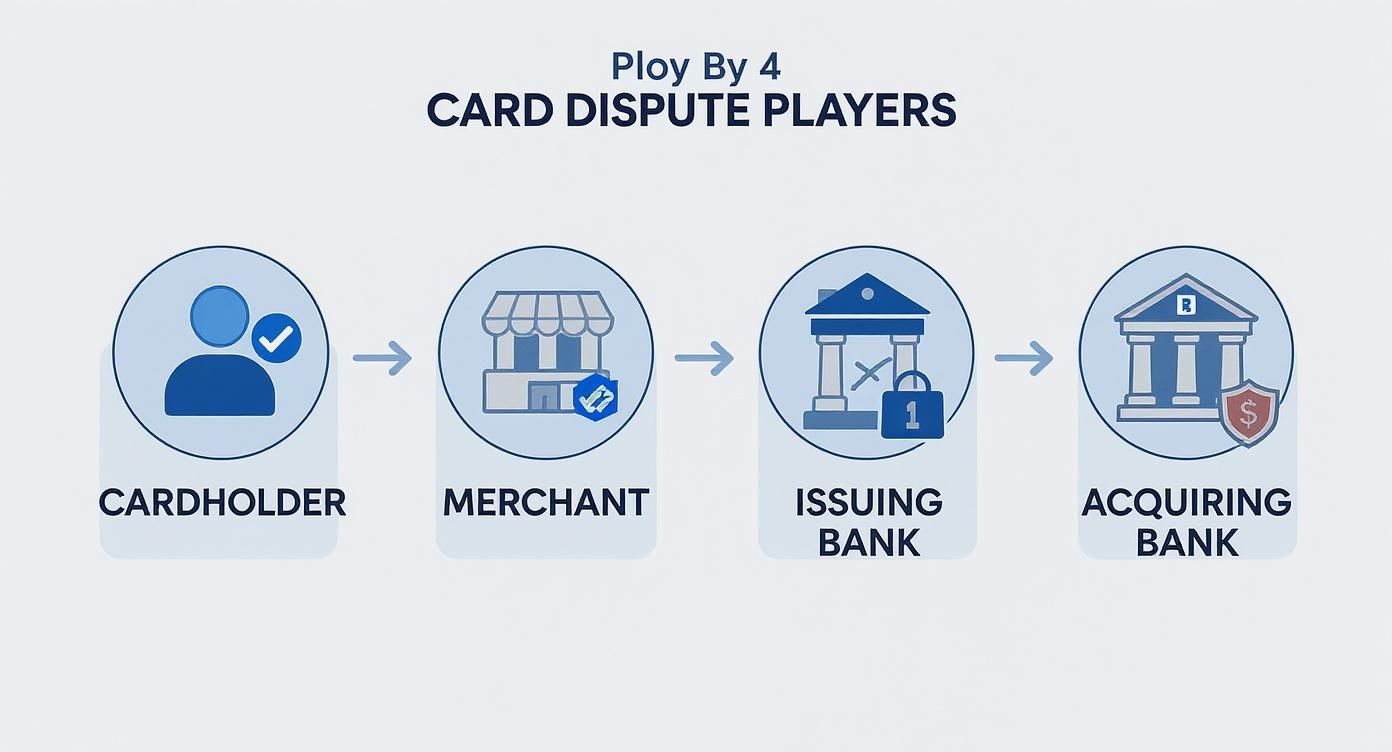
As the infographic shows, the whole thing is a back-and-forth flow of information. The banks essentially act as intermediaries, passing messages and evidence between the customer and the business until a resolution is reached.
Step 1: The Cardholder Kicks Things Off
Everything starts with the cardholder. After spotting an issue with a transaction on their statement—maybe a double charge, a subscription they cancelled, or a product that never arrived—they get in touch with their issuing bank to report it.
The customer explains exactly why they believe the charge is wrong. At this stage, the issuing bank does a quick check to see if the claim seems legitimate under the card network's rules. If it passes this initial smell test, the bank usually issues a provisional credit to the cardholder, putting the money back in their account while the investigation gets underway. This is the official start of the card dispute process.
Step 2: The Chargeback Is Filed
Once the issuing bank accepts the cardholder's claim, it formally files a chargeback against you, the merchant. This chargeback, along with a specific reason code explaining the nature of the dispute, is sent through the card network (like Visa or Mastercard) to your acquiring bank.
Your acquiring bank then pulls the disputed amount from your account and forwards the chargeback notification to you. This is often the first time a business learns that one of its transactions has been challenged. It's a critical moment because the clock starts ticking on your chance to respond.
Key Takeaway: The funds are almost always removed from your account before you've had a chance to present your side of the story. This is exactly why a swift and organized response is so crucial.
Step 3: The Merchant Responds with Representment
Now, the ball is officially in your court. You have a limited window of time, typically around 30 to 45 days, to either accept the chargeback or fight it. If you believe the charge was completely legitimate, you can challenge the dispute by submitting evidence in a process called representment.
This is where your documentation becomes your most powerful weapon. A strong representment case is built on compelling evidence that proves the transaction was valid. Think things like:
- Proof of Delivery: Shipping confirmations or tracking numbers showing the item was delivered to the correct address.
- Customer Communication: Emails, support tickets, or chat logs where the customer acknowledged the purchase or their satisfaction.
- Service Records: Invoices, signed contracts, or usage logs confirming services were rendered as agreed.
This evidence packet is sent back to your acquiring bank, which then passes it along to the issuing bank for review. For a much deeper dive into this stage, our guide on disputing a credit card transaction offers more detailed insights.
Step 4: A Final Decision Is Made
The issuing bank now has everything it needs: the customer's initial claim and your counter-evidence. Its job is to review your proof and decide if it's strong enough to invalidate the cardholder's original claim.
If your evidence is compelling, the bank will reverse the chargeback. The funds are returned to your account, the provisional credit is taken back from the cardholder, and the transaction stands. You’ve won.
However, if your evidence is weak or unconvincing, the issuing bank will uphold the chargeback. The provisional credit given to the cardholder becomes permanent, and the case is closed. You lose the revenue from the sale plus any associated chargeback fees. In very rare cases, a dispute can escalate to arbitration, but this is an expensive and time-consuming final step that most merchants try to avoid.
To help you visualize these moving parts, here’s a quick summary of the process and the typical timelines involved.
Card Dispute Process Stages and Timelines
Keeping these stages and their timelines in mind is key to managing disputes effectively. Knowing what to expect and when to act gives you the best possible chance of protecting your revenue.
Preventing Common Chargeback Triggers
While knowing your way around the card dispute process is crucial, the best strategy is always prevention. Honestly, stopping a chargeback before it even happens saves you time, money, and a ton of headaches. The first step is figuring out what actually triggers them in the first place.
Most disputes don’t just pop up out of thin air. They usually fall into one of three buckets, each with its own root causes and—more importantly—its own set of solutions.
Simple Processing Mistakes
This is the most straightforward category. These chargebacks happen because of a technical glitch or plain old human error somewhere along the payment pipeline. They’re often unintentional, but they can quickly frustrate a customer who feels they’ve been overcharged.
Common examples include things like:
- Duplicate Billing: A customer gets accidentally charged twice for the same product or service. Oops.
- Incorrect Amount: The final charge on their statement doesn't match the price they agreed to.
- System Glitches: A technical hiccup during checkout leads to a failed transaction that still gets charged.
Preventing these usually comes down to having solid systems and clear communication. Regularly auditing your payment gateway and making sure your staff is trained on the right procedures can make a huge difference.
Customer Service and Fulfillment Issues
This bucket covers disputes that spring from a gap between expectation and reality. The customer paid for something but feels they didn't get what they were promised. This is a massive source of preventable chargebacks.
Think about situations like:
- Product Not as Described: An item shows up looking completely different from the online photos or description.
- Services Not Rendered: A customer pays for a service that was never delivered or completed.
- Unclear Return Policy: A customer tries to return an item, finds the process confusing or way too restrictive, and just files a dispute instead.
The fix here is proactive customer care. Having a crystal-clear return policy, writing honest-to-goodness product descriptions, and offering responsive support can solve problems long before a customer even thinks about calling their bank.
The Challenge of Fraud
Fraud is a major driver of chargebacks and comes in two distinct flavors.
The first is criminal fraud, where a stolen card is used to make an unauthorized purchase. This is what most people think of when they hear "credit card fraud." Getting ahead of this requires a solid defense, and comprehensive online fraud prevention and brand protection can seriously reduce your risk.
The second—and often trickier—type is "friendly fraud." This is when a legitimate customer disputes a perfectly valid charge, either because they're confused or they're doing it on purpose. For instance, they might not recognize your business name on their statement and assume it’s an error.
Friendly fraud is a massive headache for merchants, accounting for up to 70% of all chargebacks. It's a key reason why merchants win only about 45% of their dispute cases.
The financial hit from these disputes is staggering, especially in certain sectors. Recent chargeback statistics show that in 2024, the travel industry saw an 816% increase in chargebacks, while e-commerce experienced a 222% jump, fueled largely by friendly fraud and service issues.
By getting a handle on these triggers, you can build a much stronger defense and keep more of your hard-earned revenue right where it belongs.
How Merchants Can Respond to a Chargeback

That chargeback notification just landed in your inbox. It’s a gut punch, for sure. It’s frustrating, and it’s easy to feel like you’re powerless. But here’s the thing: a dispute isn’t the final word. It’s the start of a conversation, and you absolutely have the right to tell your side of the story.
This is where a process called representment comes in. It’s your formal opportunity to challenge the chargeback by presenting cold, hard evidence that the original transaction was legit. Think of it like you're building a legal case. Your mission is to assemble a file of irrefutable proof that leaves zero doubt in the issuing bank’s mind that you held up your end of the deal.
Your best defense is to act fast and be methodical. Ignoring a chargeback? That's the same as pleading guilty. You automatically lose the sale and get slapped with extra fees.
Gathering Your Compelling Evidence
When it comes to winning at representment, the strength of your case is all about the quality of your evidence. Vague claims just won't fly; you need concrete, specific proof that directly picks apart the customer’s reason for the dispute. A massive part of this comes down to having your documents in order. For some great tips on this, check out this guide on efficient receipt organization.
Your goal is to paint a complete, undeniable picture of a legitimate transaction. And while the exact documents you’ll need will change depending on the dispute reason, your evidence file should always be tailored and laser-focused.
A rock-solid response usually includes a mix of these:
- Order and Transaction Details: This is your foundation. Think invoices, receipts, and any AVS (Address Verification Service) or CVV match results that prove the cardholder authorized the payment.
- Proof of Delivery: This is completely non-negotiable for "product not received" claims. Always include shipping confirmations with tracking numbers and a delivery confirmation screenshot showing the correct address.
- Customer Communications: Save everything. Seriously. Emails, support chat logs, or even social media messages where the customer talks about the purchase or expresses satisfaction are pure gold.
- Service or Digital Goods Records: If you sell services, include signed contracts or work orders. For digital products, server logs showing the customer downloaded the item or logged into their account are incredibly powerful.
Key Insight: Don't just dump a folder of files on the bank. You need to write a clear, concise rebuttal letter that walks them through your case. Explain how each piece of evidence you've attached proves the chargeback is invalid. Be their guide.
Your Essential Representment Checklist
Putting together a winning response is all about being organized. Before you hit "submit" on your case, run through this checklist to make sure all your bases are covered.
- Understand the Reason Code: First things first, identify the specific reason code for the chargeback. This tells you exactly what the customer is claiming and what kind of evidence you need to find.
- Gather All Relevant Proof: Collect every single piece of documentation related to the order, like we talked about above. As long as it's directly relevant, more is usually better.
- Write a Professional Rebuttal Letter: Clearly and calmly explain why the charge is valid. Stick to the facts and reference your evidence point-by-point. No emotion, just proof.
- Submit Before the Deadline: Chargebacks have strict deadlines, typically 30-45 days. Missing this window is an automatic loss. Don't procrastinate.
By approaching the card dispute process with a prepared, evidence-first strategy, you dramatically improve your odds of winning. To get a much deeper look at the strategies involved, our complete guide to chargeback representment is the perfect next step.
The Future of Dispute Management Technology
The old-school, back-and-forth grind of the card dispute process is finally getting a much-needed upgrade. We're seeing new technologies pop up that promise to solve disputes faster, more accurately, and sometimes, even before they officially kick off. This whole shift is about using data and smart automation to make life easier for everyone involved.
Leading the charge are real-time communication tools built by the card networks themselves. Think of platforms like Visa’s Rapid Dispute Resolution (RDR) and Mastercard’s Ethoca alerts. These systems are game-changers. They give you a heads-up the moment a customer raises an issue, opening a small window to issue an immediate refund and stop a formal chargeback in its tracks.
Smarter Data and Proactive Solutions
Another huge leap forward is the push for better, more detailed transaction data. How many times has a customer seen a cryptic billing descriptor like "NNC Services* 888-1234" and immediately assumed it was fraud? It happens all the time.
New systems are fixing this by enriching that data with clear merchant names, logos, and even purchase details right inside the customer’s banking app. That kind of clarity helps people recognize charges instantly, dramatically cutting down on those frustrating "I don't remember this" disputes.
This isn't just a nice-to-have; it's becoming essential.
Projections show that global chargebacks could hit 324 million annually by 2028, a shocking 24% increase from 2025. With digital purchases now accounting for 63% of merchant sales, smarter systems are the only way to manage the skyrocketing costs. You can find out more about the true cost of chargebacks.
Ultimately, automation is the engine powering this entire evolution. AI-driven tools are now capable of handling the entire dispute lifecycle, from analyzing the initial claim to gathering the right evidence and submitting a winning response. For businesses, this means way less manual work and a much, much better shot at recovering revenue that would have otherwise been lost. To see exactly how this works in the real world, check out our complete guide to automated chargeback and dispute management using AI.
Card Dispute Questions Answered
Let's clear up some of the most common questions that pop up around the card dispute process. Whether you're a cardholder wondering about your rights or a merchant trying to navigate the system, these quick answers have you covered.
How Long Do I Have to Dispute a Charge?
As a cardholder, you don't have forever to act. The clock starts ticking the moment the transaction happens, and you generally have between 60 to 120 days to file a dispute.
This window isn't set in stone, though. It can vary based on the card network (like Visa or Mastercard) and the specific reason you're disputing the charge. The best advice? As soon as you spot something fishy on your statement, get the ball rolling. Waiting too long could mean you miss your chance entirely.
Will Filing a Dispute Hurt My Credit Score?
Nope, filing a dispute won't ding your credit score. This process is a fundamental consumer protection right designed to help you correct errors or fight fraudulent charges. Think of it as a tool, not a black mark against your name.
That said, there can be indirect effects. For example, if a disputed account is ultimately removed from your credit report, it could slightly alter your credit history length or utilization ratio. But the act of disputing a charge itself isn't a negative event reported to credit bureaus.
A word of caution: while a single, legitimate dispute is harmless, a pattern of filing excessive or frivolous claims might catch your bank's attention. They could start to scrutinize your account activity more closely.
Can a Merchant Just Refuse a Chargeback?
In a word, no. A merchant can't just say "I refuse" and make a chargeback disappear. The moment an issuing bank initiates a chargeback, the funds are provisionally pulled from the merchant’s account. It's an automatic process.
The merchant's only move is to fight back by presenting evidence in a process called representment. If they choose to ignore the chargeback notice or can't provide a compelling case to prove the charge was valid, they lose by default.
Ready to stop losing revenue to chargebacks? ChargePay uses AI to automate the entire dispute process, generating winning responses to recover your funds hands-free. Find out how much you can reclaim.
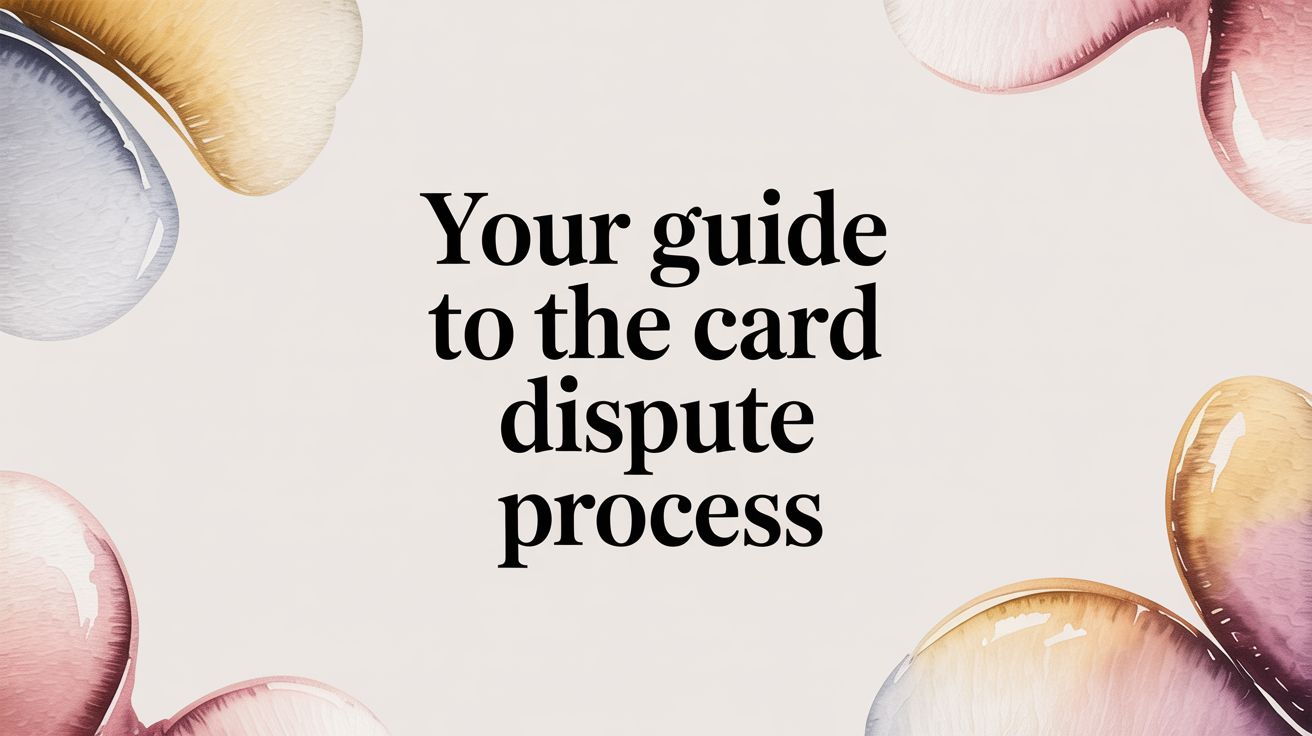


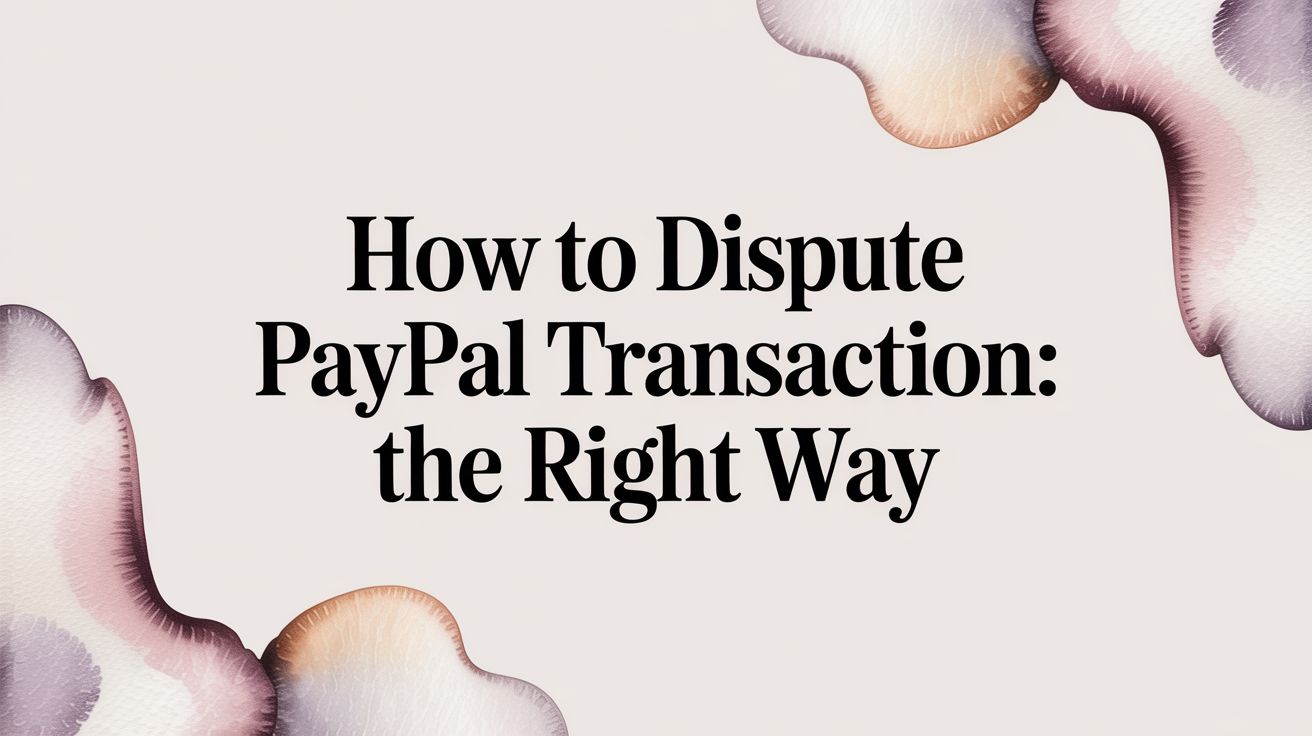
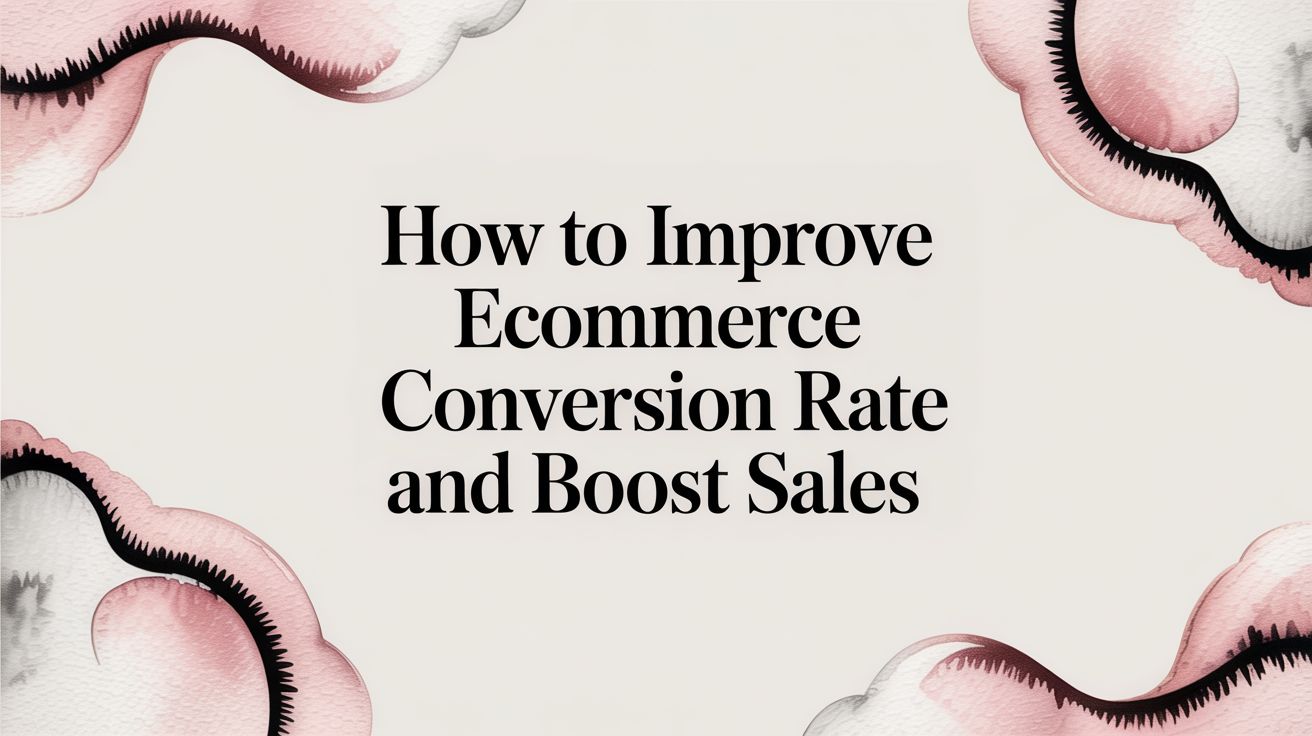
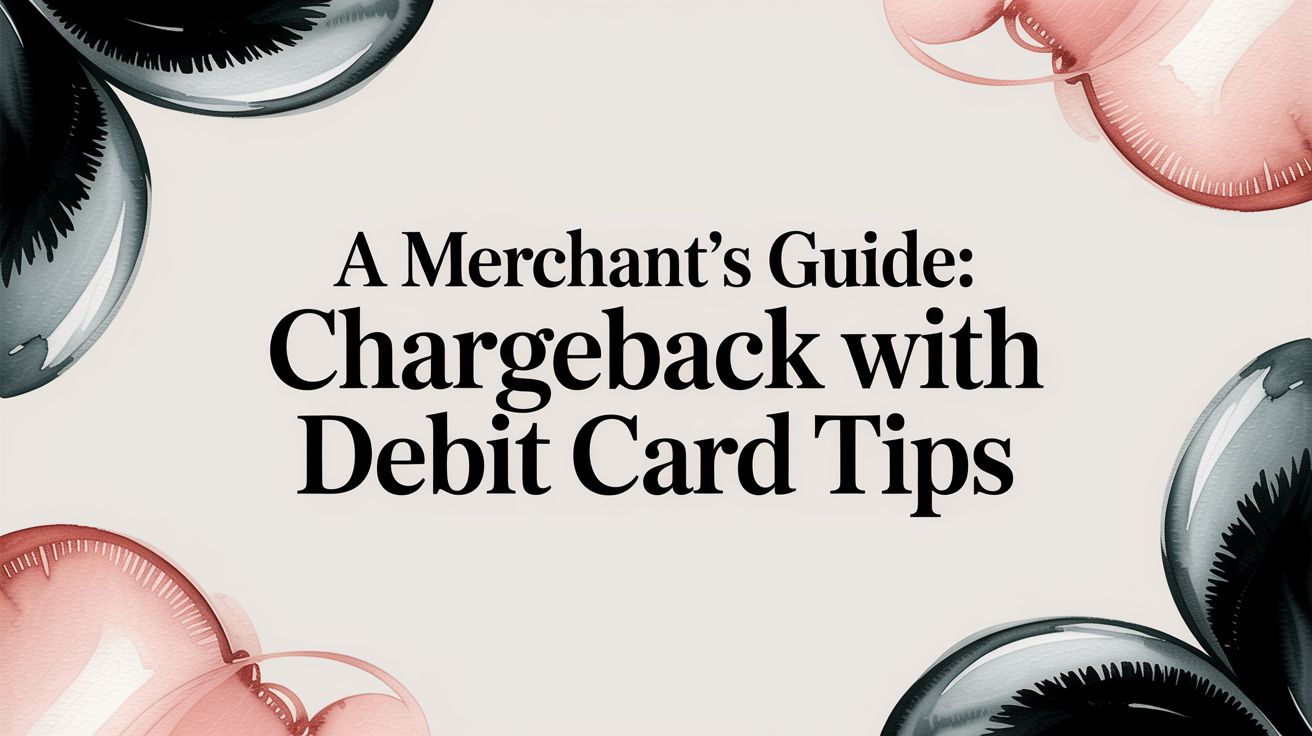

.svg)







.svg)
.svg)
.svg)